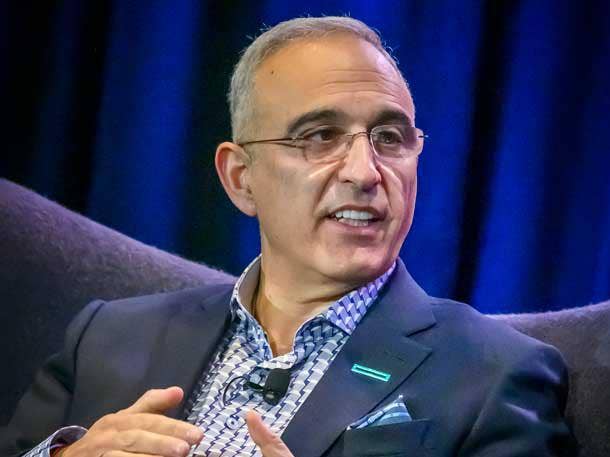HPE Stock Jumps 6 Percent On Bank Of America Double Upgrade
‘We made that decision because there was no money to be made (in the tier one hyperscale server market),’ says HPE CEO Antonio Neri of HPE’s decision to exit the tier one hyperscale server market. ‘It was very distracting. It was taking a lot of energy and time from our R&D team. Ultimately it was not a long term value creation for our shareholders.’

Hewlett Packard Enterprise shares jumped six percent or 99 cents per share to $16.34 on Monday after Bank of America Merrill Lynch double upgraded shares of HPE.
With HPE driving improved free cash flow with a higher revenue contribution from higher margin servers, Bank of America Merrill Lynch Senior Equity Research Analyst Wamsi Mohan upgraded shares of HPE to buy from underperform. The upgrade came ahead of HPE’s annual securities analyst meeting in New York on Wednesday. HPE shares are hovering near the 52-week high of $16.97 and well above the 52-week low of $12.09.
[Antonio Neri: Outposts Is AWS’ Bid To Lock Data In Public Cloud]
Paul Cohen, vice president of sales for New York-based PKA Technologies Inc., an HPE Platinum partner, said the jump in the shares is a validation of the HPE strategy.
“This validates our investment in HPE and the HPE focus on higher value, high growth, value add segments like intelligent edge and hyperconverged infrastructure,” he said. “It’s a recognition that we’re not pushing boxes and it shows we are partnered with a financially strong company that is headed in the right direction. When ever you see a bump in the stock like this it’s a real shot in the arm. It’s good for the morale and confidence of our employees who see that we have made the right decision by partnering with HPE.”
For HPE’s 2020 fiscal year, which begins Nov. 1, Mohan expects free cash flow of $2 billion, a dividend payment of $591 million and share buybacks of $800 million. That represents a capital return of about 70 percent of annual free cash flow, said Mohan.
“Our upgrade is based on free cash flow improving with fewer one-time items, management's focus on stable growth and stability of earnings, and continued strong capital returns," Mohan said in a report to clients.
Mohan is upbeat about HPE’s strategy to forego largely unprofitable tier one server sales in favor of more profitable and higher growth markets like high performance computing and hyperconverged infrastructure.
CRN reached out to Mohan but had not heard back at press time.
As for the impact of getting out of the tier one hyperscale server market, HPE CEO Antonio Neri (pictured) told 2019 Best of Breed (BoB) Conference attendees last week that the tier one server portion of HPE’s compute revenue used to be as high as 50 percent but is now negligible.
“We made that decision because there was no money to be made (in the tier one hyperscale server market),” said Neri. “It was very distracting. It was taking a lot of energy and time from our R&D team. Ultimately it was not a long term value creation for our shareholders. At its peak, we used to have almost $2 billion of our revenue selling through the tier one business – call it the Super 10. So it was more than 50 percent of our compute revenue. So we decided to work it off. Now it is almost negligible. . We transitioned the portfolio.”
Neri said that HPE has pivoted from a “commoditized business” to more of a “value business.” HPE partners and customers are adopting “blocks of IT” solutions that are allowing them are bringing big innovation benefits to customers.
“That has resulted in a significant margin improvement,” he told the BoB conference attendees. “We have three businesses: intelligent edge, hybrid IT and HPE Financial Services which I think is a core component I think our partners should leverage more.”
Under Neri’s leadership, HPE’s profitability has jumped from seven percent operating margins in the first quarter of fiscal year 2018 to 10 percent.
“The growth in strategic categories is there,” Neri told partners. “The acceleration in as a service is there. We just need to do it in a more integrated edge to cloud manner, keep driving that customer driven innovation and continue to build the portfolio together with you.”